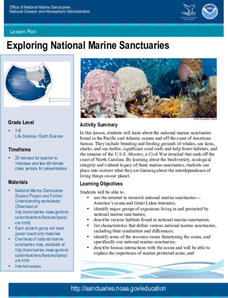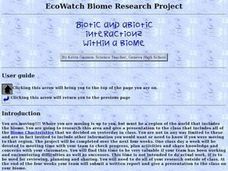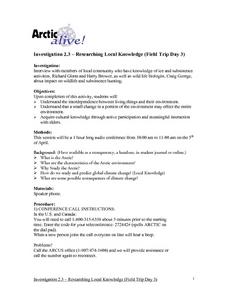Curated OER
Fun On The Farm
Students experiment with a variety of resources to study about sounds and their sources (weather, animal, and transportation). They compare size, structure, and basic needs of living things. Each student studies about farm animals,...
Curated OER
Fossil Kit II
Youngsters examine four fossil replicas and chart their time periods, vertebrate or invertebrate, and the names of other organisms living at the same time. A specific fossil kit is available for sale if you do not have the same samples....
K12 Reader
Rainforest Ecosystems
Rainforests are the topic of this brief reading passage. Learners can find out all about the different layers of the rainforest as well as the types of creatures that live there. After reading, they respond to five questions about the text.
Curated OER
Heredity: Your Connection To The Past
Young scholars investigate genetics and the process of reproduction in living organisms.
Curated OER
Number Scouts
What makes up a community? People, of couse. Then there are the other living things, such as plants and animals. There are also buildings, streets, schools, businesses, and vehicles. This activity makes students aware of one othe...
Curated OER
Life in a Drop of Water
Young scholars observe the wealth of living organisms in a drop of water from our freshwater ecosystems. They classify the types of organisms observed as single-celled or multi-cellular and use a key or chart to identify and name the...
Curated OER
Flowers, Pods, and Seeds
Students gain an understanding of living organisms. the complete a plant growth data log to chart plant growth and to make observations, predictions, and personal reflections.
Curated OER
Exploring National Marine Sanctuaries
Students conduct Internet research of the living organisms in national marine sanctuaries, and the resources protected in the sanctuaries. Students gather information about each of the sanctuaries and make an oral presentation and poster...
Curated OER
Photosynthesis: Intake of Carbon Dioxide - Production of Oxygen
Students, after a long-term observation of photosynthesis with aquatic plants, assess the benefits of photosynthesis towards all living organisms. They explain in their own words the two cycles within photosynthesis. Guided discussion...
Curated OER
Look Up - Birds
Students investigate the concept of birds. They identify five different types of birds and name the characteristics that make them different than other living things. Students also name the different parts of the bird and how they are...
Curated OER
Connect the Spheres: Earth Systems Interactions
Is everything really connected? Take your class on a walk outside, where they will make observations and write them down on a worksheet. Once they are back in the classroom, learners will work to determine if and how things like birds,...
Kenan Fellows
Use of Dichotomous Keys to Identify Stream Organisms
What kind of organisms are living in the stream? After an explanation on how to use a dichotomous key, groups of three to four use the keys to identify macroinvertebrates from a local freshwater stream. Using the the concept of Stream...
Chicago Botanic Garden
Leaf Litter Ecology Lab
Some organisms spend their entire lives in leaf litter. The third in a series of six is a great lesson exploring the community of leaf litter. Groups gather and then spread leaf litter over white paper and remove leaves/twigs while...
Curated OER
Insect Classification
Sixth graders learn the classification system of living organisms. They identify general body parts of an insect, learn insect classification into orders, families, genus and species, and classify given insects by using a scientific...
Curated OER
PLANT LIFE CYCLES
Student learns about the life cycle of plants by watching a time-lapse video. This activity provides pupils with further evidence that all living things grow and change as they progress through their life cycle.
Curated OER
Ecology - Biodiversity Lab
Studnents examine the degree of biodiversity that exists in one's everyday environment, in order to develop an understanding of how scientists classify organisms and to explain why biodiversity is important for living things.
Curated OER
Exploring the National Marine Sanctuaries: A Lesson in Habitats and Human Impacts
Students examine the marine sanctuaries in the Pacific and Atlantic Oceans. They discover the interdependence of all living things and work together in groups to create a poster about what they have discovered during the lesson. They...
Curated OER
Forest Floor Terrarium
Students study the aspects of a forest floor ecosystem, including decomposition, the water cycle, food webs, the needs of living things, and physical vs. chemical change over an extended period. In addition, students conduct observations...
Curated OER
Biotic and Abiotic Interactions Within a Biome
High schoolers work together to examine the characteristics of a biome. Using the Internet, they research the relationship between biotic and abiotic factors and living organisms. They develop a presentation along with a solution to a...
Curated OER
Researching Local Knowledge Field Trip
Students study the interdependence between living things and their environment.
Curated OER
Levels of Organization
Students read and complete a worksheet about the levels of organization of living things from cells to organ systems. They use a text book and the "Cells R Us" worksheet included to create a metaphor for each of the levels. They then...
Curated OER
Protists: animallike Protists
Students are taught that Malaria and African Sleeping sickness are caused by protists. They discuss how animal-like protists harm other living things. Students discuss and listen to the major phyla of animallike protists. They draw...
Curated OER
Systems of the Body
Third graders gather information by questioning, forming hypothesis, collecting and analyzing data, reaching conclusions and evaluating results, and communicating procedures and findings to others. Then they demonstrate an understanding...
Curated OER
Classifying Critters
In this classifying critters worksheet, students read a 1 page article on classifying living organisms and then answer 10 true or false, short answer, multiple choice or fill in the blank questions.

























